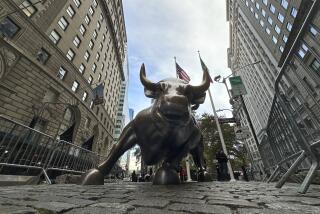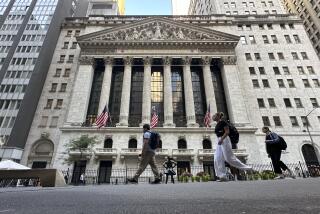Negative News Slams Stocks Hard
Blue-chip stocks on Thursday suffered one of their biggest declines of the last year, as soaring oil prices and uninspiring July retail sales reports deepened concerns about the economy.
The Dow Jones industrial average plunged 163.48 points, or 1.6%, to 9,963.03 as investors dumped shares across the board.
It was the Dow’s largest one-day loss since it fell 168.51 points on March 11. The broader Standard & Poor’s 500 and Nasdaq composite indexes fell to new closing lows for the year.
Oil prices in New York rocketed $1.58 to $44.41 a barrel, a record, after Russian authorities again barred the country’s largest oil firm, Yukos, from gaining access to its bank accounts -- threatening the company’s ability to continue pumping crude.
Oil’s relentless climb in recent weeks has weighed heavily on the stock market, in large part because of worries that higher energy prices could hurt a U.S. economy that already was showing signs of slowing down. Reports on Thursday of anemic July sales at some major retailers added to investors’ gloom by suggesting that consumers were reluctant to spend.
“There is growing concern that the economy is not in as good a shape as it seemed,” said Drew Matus, an economist at Lehman Bros. in New York.
A weaker economy could drag down corporate earnings and pull the rug from under stocks.
The government this morning will provide a key piece of information when it reports on employment trends in July. Most analysts were expecting that the report would show the economy added between 200,000 and 250,000 new jobs last month, up from 112,000 in June.
Fear that the number might be much lower than 200,000 may have encouraged some investors to bail out of stocks Thursday. The market fell steeply in the final 90 minutes of trading.
But some big investors said worries about the economy were exaggerated. They noted that recent reports on activity in the manufacturing and services sectors showed gains in July.
“I don’t think the underlying picture is bad at all,” said Robert Bissell, chief investment officer at Wells Capital Management in Los Angeles.
Still, he said, investors’ interest in stocks is being worn down by uncertainty over how high oil prices might go, terrorism and the presidential election.
“These are gnawing questions and there are no good answers to any of them” for the moment, Bissell said.
Stock trading volume Thursday was relatively subdued, so there was no massive rush for the exits. But falling stocks outnumbered winners by about 11 to 4 on both the New York Stock Exchange and Nasdaq, a wide margin.
Just one of the 30 stocks in the Dow index closed higher: Hewlett-Packard, which added 6 cents to $20.50.
Big-name stocks falling sharply included Caterpillar, down $2.08 to $69.62; J.P. Morgan Chase, off 93 cents to $36.28; and 3M, down $1.61 to $81.57.
Within the S&P; 500 index -- which slid 17.93 points, or 1.6%, to 1,080.70, its lowest close since Dec. 17 -- just three of 113 stock industry groups rose for the day.
The S&P; index’s loss was its biggest since it tumbled 1.9% on Sept. 24.
The technology-dominated Nasdaq composite fell 33.43 points, or 1.8%, to 1,821.63, its lowest close since Sept. 30.
Some analysts said the breadth of the decline on Thursday had the earmarks of the end of a market sell-off rather than the start of one. They noted that major indexes have mostly been declining since the end of June.
The S&P; 500 index is down 5.3% since June 30.
“I would side with the possibility that what we’re seeing is capitulation [by investors], which is what you see at the end of a correction,” said Tim Hayes, senior equity strategist at Ned Davis Research in Nokomis, Fla.
And so far, most major indexes’ losses from their highs this year still are within the parameters of a correction -- meaning a temporary decline in prices -- as opposed to a new bear market, analysts say.
Wall Street considers a drop of 5% to 15% to be a correction in a bull market. The Dow now is down 7.2% from its 2004 high of 10,737.70 reached on Feb. 11.
The S&P; 500 index is down 6.7% from its 2004 high, also reached on Feb. 11.
The worst-performing of the major indexes is the Nasdaq composite, which is down 15.4% from its 2004 high set on Jan. 26.
As index losses extend beyond 15% from their recent peaks, investors may begin to worry that a new bear market is developing.
But Hayes said it would be unusual for stocks to begin a steep decline in the face of a still-growing economy, robust corporate earnings and historically low interest rates.
Greg Tuorto, a specialist in technology stocks in the money management arm of Guardian Life Insurance in New York, said the heavy losses in tech shares over the last month reflect that some investors are lowering their expectations for economic and corporate profit growth.
In part, investors have reacted to warnings by some tech companies, and those in other industries, that business may be softer in the second half than what had been expected.
Even so, Tuorto said, there is no sign that demand for technology equipment suddenly is drying up as it did in 2000. “Underlying demand still is solid,” he said.
The problem for tech shares, he said, may be that they haven’t fallen enough to attract a wave of bargain-hunters.
“Tech is too cheap to sell, but not cheap enough to buy,” Tuorto said.
As stocks tumbled on Thursday, some investors opted for the relative safety of bonds. Long-term Treasury bond yields fell for a seventh straight session. The 10-year T-note dipped to 4.40% from 4.42% on Wednesday.
Worries about the economy have raised questions about whether the Federal Reserve might halt its campaign to tighten credit. The central bank on June 30 lifted its key short-term rate from 1% to 1.25%, the first increase in four years.
Policymakers meet again on Tuesday, and are expected to raise their rate to 1.5%.
“The Fed wants to be the economy’s cheerleader now,” Lehman’s Matus said. By continuing to gradually tighten credit the Fed would signal that it believes the economy remains on a growth path, he said.
* (BEGIN TEXT OF INFOBOX)
Damage survey
Most major stock indexes are down between 5% and 10% from their 2004 highsÑ still a normal market ÒcorrectionÓ by historical standards.
Stock indexesÕ percentage declines from their 2004 highs Dow utilities: -0.7% Dow transports: -4.7% S&P; 500: -6.7% Dow industrials: -7.2% NYSE composite: -7.2% S&P; mid-cap: -9.1% Russell 2,000: -12.2% Nasdaq composite: -15.4%
Source: Times research
More to Read
Inside the business of entertainment
The Wide Shot brings you news, analysis and insights on everything from streaming wars to production — and what it all means for the future.
You may occasionally receive promotional content from the Los Angeles Times.










